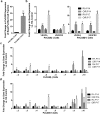The Nicotinic Cholinergic Pathway Contributes to Retinal Neovascularization in a Mouse Model of Retinopathy of Prematurity
- PMID: 28241318
- PMCID: PMC6020715
- DOI: 10.1167/iovs.16-20670
The Nicotinic Cholinergic Pathway Contributes to Retinal Neovascularization in a Mouse Model of Retinopathy of Prematurity
Abstract
Purpose: To investigate the role of nicotinic acetylcholine receptors (nAChRs) in retinal vascular development and ischemia-induced retinal neovascularization (NV).
Methods: The expression of nAChR subtypes and VEGF signaling pathway components was assessed in mice with and without oxygen-induced ischemic retinopathy by comparing expression levels at postnatal day (P) 14 and P17 in mice exposed to 75% oxygen from P7 to P12 and returned to room air versus mice pups that were exposed to ambient oxygen levels during the same period. The effect of topical or intraocular injection of mecamylamine, a nonspecific nAChR antagonist, or targeted deletion of α7- or α9-nAChRs on ischemia-induced retinal NV was determined by comparing the amount of retinal NV at P17 in these mice versus appropriate controls.
Results: The expression of nAChR subunits and components of the VEGF signaling pathways was increased in ischemic retina. Topical application or intraocular injection of mecamylamine decreased retinal NV in this model. Mecamylamine had no effect on normal retinal vascular development or on revascularization of the central retinal area of nonperfusion in mice with ischemic retinopathy. Targeted deletion of α9, but not α7, nAChR receptor subunits reduced retinal NV in mice with ischemic retinopathy.
Conclusion: These data suggest that nAChR signaling, primarily through the α9 nAChR subunit, contributes to ischemia-induced retinal NV, but not retinal vascular development. Mecamylamine or a specific α9 nAChR antagonist could be considered for treatment of retinopathy of prematurity and other ischemic retinopathies.
Figures




Similar articles
-
Protective effects of rapamycin on the retinal vascular bed during the vaso-obliteration phase in mouse oxygen-induced retinopathy model.FASEB J. 2020 Dec;34(12):15822-15836. doi: 10.1096/fj.202001295R. Epub 2020 Oct 25. FASEB J. 2020. PMID: 33103304
-
Soluble forms of EphrinB2 and EphB4 reduce retinal neovascularization in a model of proliferative retinopathy.Invest Ophthalmol Vis Sci. 2005 Jun;46(6):2175-82. doi: 10.1167/iovs.04-0983. Invest Ophthalmol Vis Sci. 2005. PMID: 15914639
-
Effects and Mechanism of Action of PX-478 in Oxygen-Induced Retinopathy in Mice.Ophthalmic Res. 2020;63(2):182-193. doi: 10.1159/000504023. Epub 2020 Jan 17. Ophthalmic Res. 2020. PMID: 31955159
-
Retinal vascular development and oxygen-induced retinopathy: a role for adenosine.Prog Retin Eye Res. 2003 Jan;22(1):95-111. doi: 10.1016/s1350-9462(02)00058-7. Prog Retin Eye Res. 2003. PMID: 12597925 Review.
-
Adenosine receptors and caffeine in retinopathy of prematurity.Mol Aspects Med. 2017 Jun;55:118-125. doi: 10.1016/j.mam.2017.01.001. Epub 2017 Jan 11. Mol Aspects Med. 2017. PMID: 28088487 Free PMC article. Review.
Cited by
-
The Spinal α7-Nicotinic Acetylcholine Receptor Contributes to the Maintenance of Cancer-Induced Bone Pain.J Pain Res. 2021 Feb 15;14:441-452. doi: 10.2147/JPR.S286321. eCollection 2021. J Pain Res. 2021. PMID: 33623426 Free PMC article.
-
Paxillin promotes the migration and angiogenesis of HUVECs and affects angiogenesis in the mouse cornea.Exp Ther Med. 2020 Aug;20(2):901-909. doi: 10.3892/etm.2020.8751. Epub 2020 May 14. Exp Ther Med. 2020. PMID: 32742332 Free PMC article.
-
The angiogenic role of the alpha 9-nicotinic acetylcholine receptor in triple-negative breast cancers.Angiogenesis. 2024 Nov;27(4):827-843. doi: 10.1007/s10456-024-09944-6. Epub 2024 Aug 23. Angiogenesis. 2024. PMID: 39177676
-
Neuronal Menin Overexpression Rescues Learning and Memory Phenotype in CA1-Specific α7 nAChRs KD Mice.Cells. 2021 Nov 24;10(12):3286. doi: 10.3390/cells10123286. Cells. 2021. PMID: 34943798 Free PMC article.
References
-
- Villablanca AC. . Nicotine stimulates DNA synthesis and proliferation in vascular endothelial cells in vitro. J Appl Physiol. 1998; 84: 2089– 2098. - PubMed
-
- Heeschen C, Jang JJ, Weis M,et al. . Nicotine stimulates angiogenesis and promotes tumor growth and atherosclerosis. Nat Med. 2001; 7: 833– 839. - PubMed
Publication types
MeSH terms
Substances
Grants and funding
LinkOut - more resources
Full Text Sources
Other Literature Sources
Molecular Biology Databases

